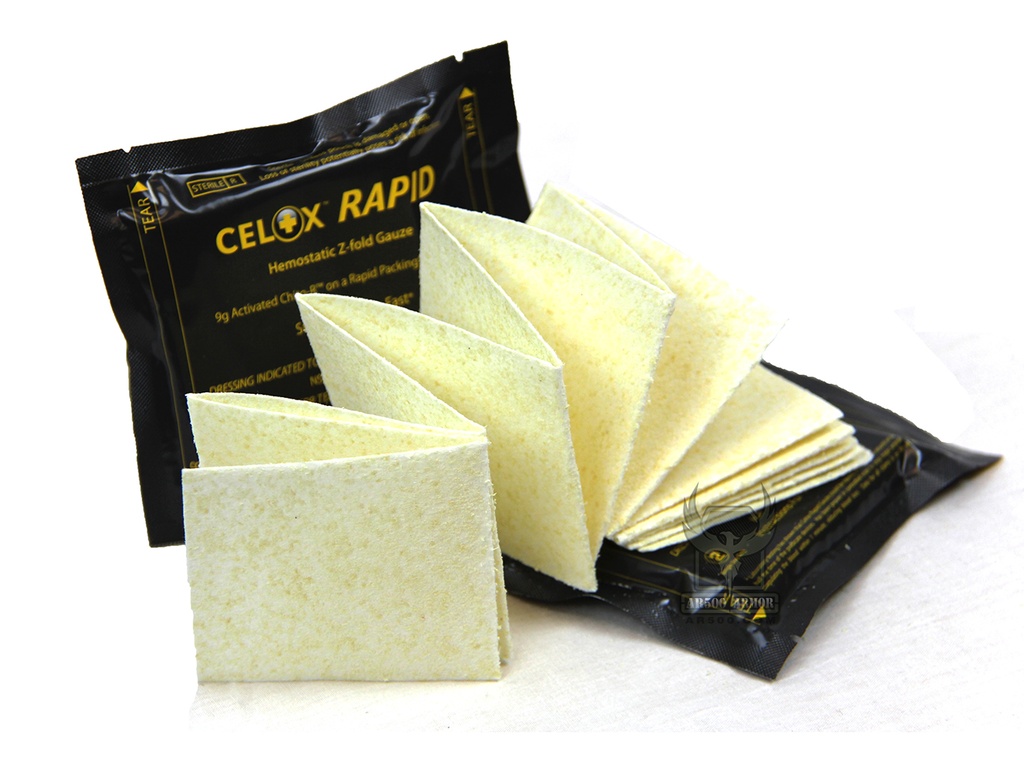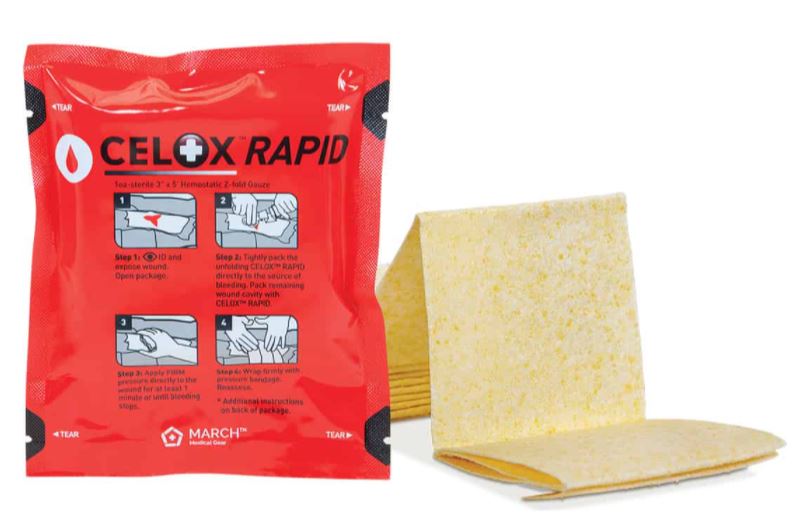DRESSING, HAEMOSTAT., chitosan rapid Z-fold. 7X150cm (Celox)
Valid Article
HAEMOSTATIC DRESSING, chitosan
Definition
A sterile, non-bioabsorbable dressing made with chitosan intended to be applied to traumatic wounds in emergency situations (e.g., road accidents, combat, emergency rescue) to produce a rapid haemostasis by forming a robust plug of gel which is removed after use; it is not intended for surgical use.
Haemostatic agents use is limited to the severe-moderate bleeding as temporarily dressing before referral to the closest hospital before definitive control.
Specifications
Mucoadhesive agents create a strong adherence to tissues and physically seal bleeding wounds. Most brands use chitosan, a naturally occurring, bio-compatible polysaccharide derived from shellfish, and work in this fashion.
On contact with anionic erythrocytes, the chitosan salts rapidly ‘cross-link', adhering strongly with the wound surface. This adhesive process is thought to be the primary mechanism of action; independent of platelets or clotting factors.
Chitosan is extracted from shrimp shells, there are however no cases on record of allergic reaction to chitosan based haemostatics, even in those with a known seafood allergy.
Technical specifications
- Z-folded viscose compress
- 8 g of chitosan granules (high surface area macro-granules) on the compress
- Sterile, for single use
- 7.6 x 152 cm gauze strip
- 14 x 11 x 1.4 cm foil pouch
- weight = 32 g
Packaging & Labelling
Each sterile dressing is individually wrapped in a vacuum metallized pack with the IFU printed on the outside.
Instructions for use
The primary treatment for all serious bleeds is direct pressure; all haemostatics are designed to be used with direct pressure at the site of the bleed – directly onto the bleeding artery, deep within the wound if necessary. Haemostatic dressings are not a ‘magic powder' that can be casually applied somewhere near the wound and left to work.
- Tear open pack. Take out the Celox and take one end of the Z-folded gauze.
- Tightly pack the unfolding Celox directly to the source of the bleeding. Pack remaining wound cavity with Celox or standard gauze. Excess Celox can be torn or cut if necessary.
- Apply FIRM pressure directly to the wound for AT LEAST ONE MINUTE or until bleeding stops.
- Wrap and tie with a bandage so as to maintain pressure on the wound.
- Discard any remaining Celox.
- Transfer patient to medical facility as soon as possible.
- Show empty pack to medical personnel (do not assume the hospital will know how to deal with the haemostatic you have applied)
For further care: physically remove gauze from the wound and any loose surface granules. Fully flood entire wound area with sterile saline irrigation solution. Proceed with normal irrigation and / or suction. Ensure all product is removed from the wound prior to initiation of wound treatment.
Precautions for Use
- Device not intended for surgical (internal) use as it is not X-Ray detectable.
- Do not apply over eyes. If eye irritation occurs flush with water for five minutes.
Storage
- Store below 30°C





![[KMEDMHIS22-] (mod ICU) SPECIFIC DRESSINGS complementary 2021](/web/image/product.template/574343/image_256/%5BKMEDMHIS22-%5D%20%28mod%20ICU%29%20SPECIFIC%20DRESSINGS%20complementary%202021?unique=4195f0f)
![[KMEDKHAS2CO] AMP, PART medicines & renewable supplies, complete](/web/image/product.template/572649/image_256/%5BKMEDKHAS2CO%5D%20AMP%2C%20PART%20medicines%20%26%20renewable%20supplies%2C%20complete?unique=ae6983d)
![[KMEDKHCS2CO] OPD, PART medicines & renewable supplies, complete](/web/image/product.template/572653/image_256/%5BKMEDKHCS2CO%5D%20OPD%2C%20PART%20medicines%20%26%20renewable%20supplies%2C%20complete?unique=51d17bd)
![[KMEDKHES2CO] EMERGENCY ROOM, PART medicines & renew. supplies, complete](/web/image/product.template/572657/image_256/%5BKMEDKHES2CO%5D%20EMERGENCY%20ROOM%2C%20PART%20medicines%20%26%20renew.%20supplies%2C%20complete?unique=51d17bd)
![[KMEDKFAI5RS] MOBILE MEDICAL BAG KIT, rucksack](/web/image/product.template/572106/image_256/%5BKMEDKFAI5RS%5D%20MOBILE%20MEDICAL%20BAG%20KIT%2C%20rucksack?unique=8ab3cc9)